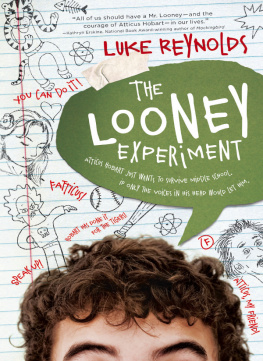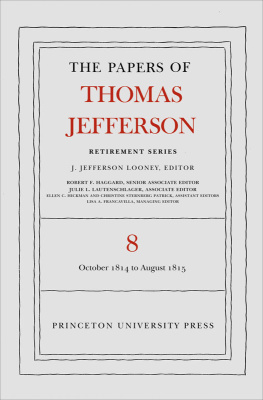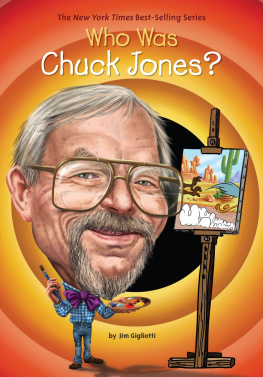

Sutherland House
416 Moore Ave., Suite 205
Toronto, ON M4G 1C9
Copyright 2021 by Jaime Weinman
All rights reserved, including the right to reproduce this book or
portions thereof in any form whatsoever. For information on rights and
permissions or to request a special discount for bulk purchases, please
contact Sutherland House at
Sutherland House and logo are registered
trademarks of The Sutherland House Inc.
First edition, October 2021
If you are interested in inviting one of our authors to a live event or
media appearance, please contact
and visit our website at sutherlandhousebooks.com for more
information about our authors and their schedules.
Manufactured in Canada
Cover designed by Jason Logan
Book composed by Karl Hunt
Library and Archives Canada Cataloguing in Publication
Title: Anvils, mallets & dynamite : the unauthorized biography of Looney tunes / Jaime Weinman.
Other titles: Anvils, mallets and dynamite
Names: Weinman, Jaime, author.
Identifiers: Canadiana 20210256850 | ISBN 9781989555460 (hardcover)
Subjects: LCSH: Looney tunes. | LCSH: Warner Bros. CartoonsHistory. | LCSH: Warner Bros. AnimationHistory. | LCSH: Animated films
United StatesHistory and criticism. | LCSH: Animated television
programsUnited StatesHistory. | LCSH: Cartoon charactersUnited States.
Classification: LCC NC1766.U53 L669 2021 | DDC 791.43/340973dc23
ISBN: 978-1-989555-46-0
To my mother, who remembers that when I was a child, I would point at a cartoon gag and ask, Why is that funny?
Who Are These Talking Animals, and Why Do We Care?
Mickey Mouse is not a funny character. He neither tells jokes nor does anything funny, he has no point of view, no real character, and his girlfriend is an uptight bore. Bugs Bunny, on the other hand, is a brilliantly inventive comic genius, sharp-witted, physically agile, a fearless wise-guy who thinks nothing of donning a dress, producing an anvil out of thin air, kissing his enemy on the lips, and, in the face of death and torture, calling out a cheery, Whats up, Doc? Bugs is much funnier than Mickey, no contest. Why, then, is Mickey the billionaire movie star? People dont seem to be able to get their fill of that little rat, him with his squeaky voice and gee-whiz attitude. Mickey is completely inoffensive, involved in a long-term, caring relationship, optimistic. Bugs is the opposite: hes a wild man with a raging carrot-dependency, big with the exploding props and the verbal abuse, and one of these days hes going to go over the edge. Mickey never will. He and his girlfriend will spend their days in inoffensive, unfunny bliss. But it is Bugs who makes us laugh, and isnt that, after all, enough?
Rob Long, Conversations with My Agent
T HE FIRST THING WE NOTICE about Looney Tunes on a movie theater screen is that the characters are looking down at us. When Daffy Duck looks out into the audience and apologizes for the fact that a giant eraser almost removed him from the picture, hes not looking directly in front of him. His eyes are focused on a position below the camera, an acknowledgment that he is up there, on a large screen, and were down here.
I knew that about the old Warner Bros. cartoons with Bugs Bunny, Daffy Duck, Porky Pig, the Road Runner, Tweety, Sylvester, Speedy Gonzales, Foghorn Leghorn, and that singing frog in the top hat. Even though I had watched them on television on Saturday mornings, I knew that they hadnt been made for television, but for movie theaters. The Warner Bros. studio had cranked out hundreds of them between 1930, when the franchise began, and 1963, when it officially shut down. I knew all that, but I didnt really feel it until I saw them on a big theater screen.
It was my second time seeing this touring festival. I had gone to see it in Ottawa, where I grew up, and when it came to Montreal, where I was studying. Having seen it twice, I considered going out on the road to see it in other cities, but I wasnt as big a fan as that, although I still kind of regret not traveling considering how hard its become to see these cartoons as they were intended to be seen.
Warner Bros. had sent this festival package out to repertory theaters with good 35 mm prints drawn from the cartoons it owned. It mixed a bunch of classics, like Whats Opera, Doc? (Bugs Bunny and Elmer Fudd do Wagner) and One Froggy Evening (the singing frog) with seemingly random shorts featuring other popular characters, plus two bonus shorts with the Tasmanian Devil, an ugly, slobbering beast who had only appeared in five cartoons but somehow became one of the studios most popular characters in the 1980s and 1990s, even getting his own TV show for a while.
It was a good but not great selection of cartoons, thanks in part to one big limitation, the necessary fact that it was restricted to the cartoons Warner Bros. owned. It sounds strange in our era of entertainment company consolidation, but the rights to Looney Tunes cartoons were divided, and Warner Bros. didnt own half the films it had made. In the 1950s, when television was new and movie studios were desperate for extra money, Warner Bros. sold its pre-1948 film library to a distribution company that needed cheap filler to sell to TV stations. This decision cost the studio many times over the $21 million it received, and while the library changed hands many times afterward, it was still in the hands of a Warner Bros. competitor, Ted Turner, who used them as cheap filler on his cable channel Cartoon Network.
All of this meant that the festival could only choose from cartoons released after 1948. A lot of the best shorts couldnt be included, and the ones on the program tended to be a bit too similar in style: the 1950s were not a period that had much use for anarchy, so Bugs Bunny and Daffy Duck had lost most of the wildness they displayed in the 1940s. It was a bit too easy to predict what they were going to do in every cartoon. Watching them one after the other, they seemed the work of skilled artists who were maybe a bit too familiar with what got laughs and a little too willing to repeat themselves.
But then these cartoons were never meant to be watched one after the other, even though that was how most of us grew up watching them. The original Warner Bros. cartoon studio was in the business of making short animated films to play before the studios live-action movies, back when most movie theaters would show a cartoon, a newsreel, and other short films before the main feature. The cartoons were meant to be consumed one at a time. Because the creators only had six or seven minutes to tell their stories, there was none of the slow build that you see in comedy features, or even in the twenty-minute shorts by live-action comedians like the Three Stooges or Laurel and Hardy. Almost every long comedy film has some quiet moments, or moments that arent intended to get big laughs. Otherwise, the audience would get exhausted. A Looney Tunes cartoon wasnt worried about exhaustion. Each cartoon bombards us with jokes, gags, explosion effects, and weird sounds to force us to laugh as hard and as often as we can before it gets the hook. This is why, in every screening I saw, the laughs were less enthusiastic in the second half of the program. This was mostly because you cant laugh equally hard at twelve cartoons in a row. When you add them all together, you dont get a feature film, you feel as if youre watching twelve two-hour features in a row without a break.
Next page












